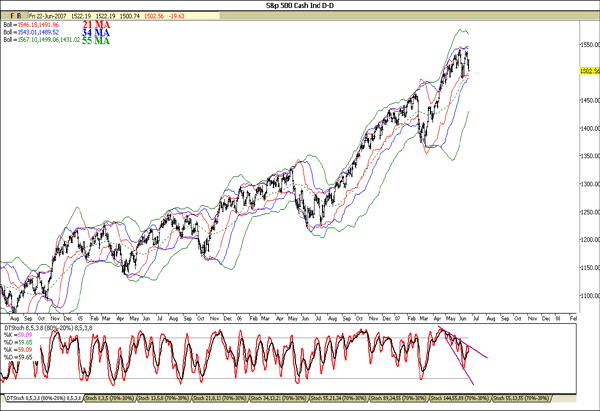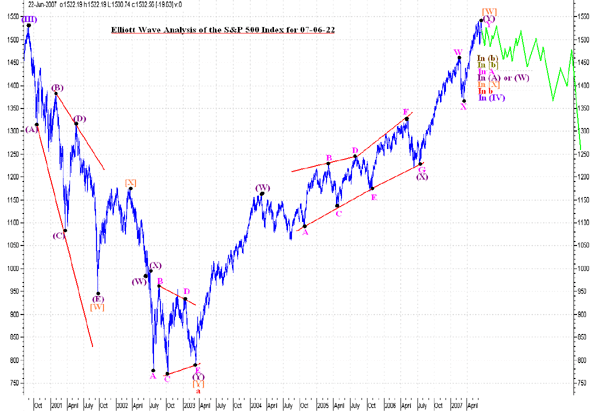Stock Market Forming Topping Pattern
Stock-Markets / US Stock Markets Jun 25, 2007 - 12:31 AM GMTBy: David_Petch
I am glad I waited for one more day to examine the S&P, because the volatility confirms that a topping formation is underway and likely will last into September/October (most likely October). The US Dollar declined sharply today and a falling US stock market makes the decline a double whammy.
The upper 55 MA Bollinger band curling down did confirm a top, with the depth of the lower 55 MA Bollinger band suggestive a decline to 1440 is probable but not for 2-4 weeks. Short-term stochastics have the %K beneath the %D within the confines of an expanding stochastic wedge. Given the volatility witnessed during the past two weeks, I do not want to even try and catch every zig and zag. Rather I want to focus on the markets having a chronological decline type of topping process over the course of the next 3-4 months before declining.
Figure 1

Red lines on the right hand side represent Fibonacci price projects of upward trending wave price action projected off their subsequent lows. Areas of line overlap form Fib clusters, which indicate important support/resistance levels. The 1532 Fib cluster marked the top, which coincided with the upper trend line of the channel formed from the July 2006 and March 2007 lows. There is significant Fib support so 1440, which could be the bottoming portion of the current decline phase. Failure for the S&P to remain above 1440 would see a sharp decline to 1370. We will have to examine the pattern development on a week to week basis, but the top that forms should have a declining pattern of lower highs before a sharp decline this fall. Moving averages are in bullish alignment (50 day MA above the 155 day MA above 200 day MA), with the 50 day MA acting as support at 1500. Full stochastics have the %K beneath the %D, which has approximately 2-4 weeks to bottom before heading higher.
Figure 2

The weekly S&P 500 Index chart is shown below, with Fibonacci time extensions of the decline from 2000 until early 2003 and Fib price retracements of the decline shown on the right hand side (denoted in blue). Notice how the S&P has moved within Fib channels since late 2003. Every time the S&P moved through a higher Fib level, it broke higher only to back test the breakout and again go higher. Since the pattern has worked well, there is not reason to assume this trend will not continue. The S&P is going to test 1368 (may as well be 1372 as per Figure 2) at some point between now and October before declining to 1241.
The lower 55 week MA Bollinger band has started to curl up, suggestive the top is in place. Given the depth of the lower 55 week MA BB, it is too low to have an outright crash; allow for 3-4 months to pass and this will see a reduction in the volatility thereby allowing the decline phase to commence. Full stochastics have the %K above the %D within the confines of a rising stochastic wedge. The %K may cross beneath the %D but likely will remain inside the wedge for another 3-4 months. Failure for the %K to remain above the lower trend line of the rising wedge will see an instant decline of significant proportion. Things “should” continue to muddle along until early October, but if some unforeseen event were to occur, it could be a trigger.
Figure 3

The mid-term Elliott Wave chart of the S&P 500 Index is shown below. I decided to reduce the time frame of the chart, since it was starting to get backed up. The move up in wave [W] is complete, with wave [X] currently underway. The green line on the right hand side denoting the thought market path is not properly fit to the time scale. The pattern could happen in one week or 3 weeks……focus more on the pattern objectives that the time objectives.
Figure 4

The long-term Elliott Wave chart of the S&P 500 Index is shown below, with the thought pattern denoted in green and again, it is not accurately fit to the time scale. The S&P is likely forming a flat for a lower Degree of wave [X] (uncertain if it is Minor Degree (first portion of wave [X] or of Intermediate Degree (one third of the corrective phase underway). When the 1370 area gets hit later, expect a rebound to just below 1500, before starting a rapid decline to 1240ish. Wave b has had 1/3 of the pattern complete, with wave [X] being an intermediary corrective phase between wave [W] and wave [Y] yet to form.
Figure 5

That is all for this early AM. I will update the base metal portfolio stocks later on tomorrow night. Have a great day tomorrow.
By David Petch
http://www.treasurechests.info
The main focus of my work pertains to analysis of the USD index, S&P 500 Index, 10 Year US Treasury Index, AMEX Gold BUGS Index and the AMEX Oil Index using market analysis specified in a former article I wrote titled “The Technical Palette” (Elliott Wave, Bollinger bands, stochastics). We also cover around 30-40 gold/silver, base metal and energy stocks, which have done quite well recently. If this is the kind of analysis you are looking for, we invite you to visit our new and improved web site and discover more about how our service can further aid you in achieving your financial goals. For your information, our new site includes such improvements as automated subscriptions, improvements to trend identifying / professionally annotated charts, to the more detailed quote pages exclusively designed for independent investors who like to stay on top of things. Here, in addition to improving our advisory service, our aim is to also provide a resource center, one where you have access to well presented 'key' information concerning the markets we cover. And if you have any questions, comments, or criticisms regarding the above, please feel free to drop us a line . We very much enjoy hearing from you on these matters.
Copyright © 2007 treasurechests.info Inc. All rights reserved.
Unless otherwise indicated, all materials on these pages are copyrighted by treasurechests.info Inc. No part of these pages, either text or image may be used for any purpose other than personal use. Therefore, reproduction, modification, storage in a retrieval system or retransmission, in any form or by any means, electronic, mechanical or otherwise, for reasons other than personal use, is strictly prohibited without prior written permission.
Disclaimer: The above is a matter of opinion and is not intended as investment advice. Information and analysis above are derived from sources and utilizing methods believed reliable, but we cannot accept responsibility for any trading losses you may incur as a result of this analysis. Comments within the text should not be construed as specific recommendations to buy or sell securities. Individuals should consult with their broker and personal financial advisors before engaging in any trading activities as we are not registered brokers or advisors. Certain statements included herein may constitute "forward-looking statements" with the meaning of certain securities legislative measures. Such forward-looking statements involve known and unknown risks, uncertainties and other factors that may cause the actual results, performance or achievements of the above mentioned companies, and / or industry results, to be materially different from any future results, performance or achievements expressed or implied by such forward-looking statements. Do your own due diligence.
David Petch Archive |
© 2005-2022 http://www.MarketOracle.co.uk - The Market Oracle is a FREE Daily Financial Markets Analysis & Forecasting online publication.
Comments
|
Nina de Costa
21 Jul 08, 11:37 |
S&P Average Market Recovery Time
Would you happen to know the average historical time it has taken for the stock market to recover? |



